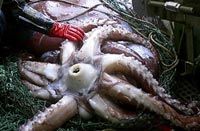 This isn’t a new, but I find it fascinating nevertheless. Larger than the giant squid, the colossal squid has never been seen alive. Two years ago an autopsy was performed in New Zealand on the biggest intact colossal squid ever collected.
This isn’t a new, but I find it fascinating nevertheless. Larger than the giant squid, the colossal squid has never been seen alive. Two years ago an autopsy was performed in New Zealand on the biggest intact colossal squid ever collected.
Alien Autopsy: Inside a Big Squid
The colossal squid is a shy sort of predator. It’s never been seen alive, preferring to hang out at depths of 1 km or more in the icy blackness of Antarctic waters, where it picks out its prey with eyes bigger than a human head, and seizes it with tentacles tipped with up to 25 rotating hooks that can swivel 360 degrees. Yet this week, one Mesonychoteuthis hamiltoni finally entered the spotlight, undergoing a very public autopsy carried out in New Zealand and broadcast around the world online.
The 495-kg creature has been on ice at Wellington’s Te Papa Museum since a fishing crew hauled it aboard, snagged on one of its long lines in the Ross Sea in February 2007. But if it’s tough work catching a colossal squid, it’s even harder to thaw it—as the international team of squid scientists assembled to examine it have found. This week, followed by a documentary film crew and web audience of several thousand, they clambered into a tank of salty, icy water with the squid to gently tease its tentacles and body into shape. After waiting so long to get close to such a prize, the scientists had a tight deadline—the tissue is so fragile that it needed to be preserved in formalin after samples were taken. But Te Papa’s director of natural environment, Carol Diebel, says even with limited study time the team was thrilled: “They’ve already got so much more out of this than they expected.”
In Frank Bullen’s classic book, The Cruise of the Cachalot Round the World After Sperm Whales, published in 1899, he describes an encounter between a huge squid and a sperm whale.
A very large sperm whale was locked in deadly conflict with a cuttle-fish or squid, almost as large as himself, whose interminable tentacles seemed to enlace the whole of his great body. The head of the whale especially seemed a perfect net-work of writhing arms–naturally I suppose, or it appeared as if the whale had the tail part of the mollusc in his jaws, and, in a business-like, methodical way, was sawing through it. By the side of the black columnar head of the whale appeared the head of the great squid, as awful an object as one could well imagine even in a fevered dream. Judging as carefully as possible, I estimated it to be at least as large as one of our pipes, which contained three hundred and fifty gallons; but it may have been, and probably was, a good deal larger. The eyes were very remarkable from their size and blackness, which, contrasted with the livid whiteness of the head, made their appearance all the more striking. They were, at least, a foot in diameter, and, seen under such conditions, looked decidedly eerie and hobgoblin-like. All around the combatants were numerous sharks, like jackals round a lion, ready to share the feast, and apparently assisting in the destruction of the huge cephalopod. So the titanic struggle went on, in perfect silence as far as we were concerned, because, even had there been any noise, our distance from the scene of conflict would not have permitted us to hear it.
